Related Research Articles

The Northrop C-19 Alpha was a series of three aircraft purchased from Northrop by the US Army Air Corps in 1931. They were slightly modified versions of the civil Northrop Alpha Type 2.
The IAR-825 Triumf is a Romanian-designed tandem multirole trainer aircraft based on the IAR-823 built for the Romanian Air Force. The aircraft is roughly in the same class with the Brazilian EMBRAER Tucano. The IAR-825 is equipped with the Canadian Pratt & Whitney Canada PT6 turboprop engine. The type's first flight took place on the 12 June 1982.

The Cessna 441 Conquest II is the first turboprop powered aircraft designed by Cessna and was meant to fill the gap between their jets and piston-engined aircraft. It was developed in November 1974, with the first aircraft delivered in September 1977. It is a pressurized, 8–9 passenger turbine development of the Cessna 404 Titan. The ICAO designator as used in flight plans is C441.

The Cessna 425, known as the Corsair and later as the Conquest I, is an eight-seat American pressurized turboprop twin-engined light aircraft. Now out of production, it was built by Cessna Aircraft of Wichita, Kansas, between 1980 and 1986.
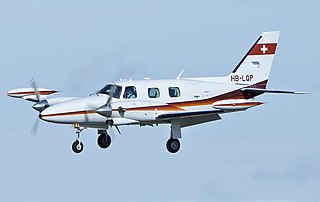
The Piper PA-31T Cheyenne is a turboprop development of the earlier PA-31P Pressurized Navajo.

The Beriev Be-30 is a Russian regional airliner and utility transport aircraft designed by the Beriev Design Bureau. It was developed specifically for Aeroflot local service routes using short, grass airstrips. It was also designed to be used in the light transport, aerial survey and air ambulance roles. It competed against the Antonov An-28 and the Czechoslovakian LET-410.

The Saunders ST-27 was a regional aircraft built in the 1970s by the Canadian Saunders Aircraft Company based at Gimli, Manitoba. The aircraft was designed as a conversion of the earlier de Havilland Heron. The conversion program was extensive and featured two Pratt & Whitney Canada PT6 turboprops and a stretched fuselage. Despite its promise as a regional airliner, the project collapsed when Manitoba government funding was withdrawn in 1976.

The PZL-106 Kruk is a Polish agricultural aircraft designed and built by WSK PZL Warszawa-Okęcie.

The Beriev Be-112 is a proposed amphibian aircraft with two propeller engines, projected to carry 27 passengers. The Beriev firm lacks a production amphibian aircraft in this size.

The Avtek 400A was an American prototype turboprop-powered business aircraft, which was developed in the early 1980s. Its configuration was unusual and distinctive : a low-wing monoplane with two pusher engines mounted above the wings, and a large canard mounted atop the forward fuselage. The aircraft's sleek, futuristic design earned it a guest appearance on the Airwolf TV series as the X-400, which was used by the villain, Lou Stappleford in the Eagles episode.
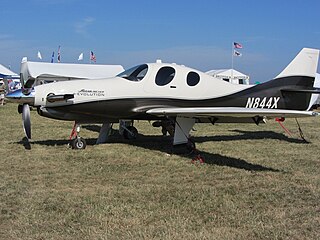
The Lancair Evolution is an American pressurized, low wing, four-place, single engine light aircraft, made from carbon fiber composite, developed by Lancair and supplied as an amateur-built kit by Evolution Aircraft.

The IAR-827 was an agricultural aircraft built in Romania in the 1970s and 1980s. The penultimate member of the family of designs that began with the IAR-821, it was, like the others, a conventional low-wing monoplane with fixed, tailwheel undercarriage, and shared the all-metal construction of the IAR-826. The prototype flew in 1976, powered by a Lycoming IO-720 engine, but the production examples that followed all had the PZL-3S.

The NAC Fieldmaster was a British agricultural aircraft of the 1980s. A turboprop powered single-engined monoplane, it was built in small numbers and used both as a cropsprayer and a firefighting aircraft.
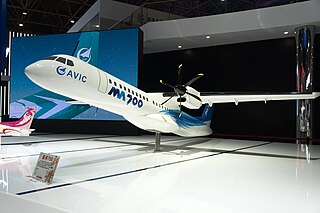
The Xi'an MA700 is a twin-engine, medium-range turboprop airliner currently under development by Xi'an Aircraft Industrial Corporation of the Aviation Industry Corporation of China (AVIC).
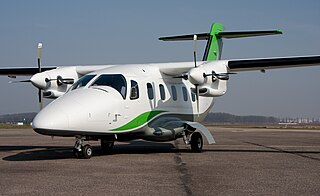
The Evektor EV-55 Outback is a twin-engine turboprop aircraft designed and built in the Czech Republic by Evektor-Aerotechnik. The prototype first flew on 24 June 2011. The project's development was suspended in March 2017.

The Lockheed L-1249 Super Constellation was a turboprop-powered version of the Lockheed Constellation aircraft family. Built in 1954 and 1955, the aircraft were used as prototypes for possible future military transport aircraft for both the United States Air Force and United States Navy. Both aircraft saw very short lives and the airframes were later used to build L-1049 Super Constellations.
The Smith X-99 Prop-Jet was a six-seat turboprop powered business aircraft designed in the United States in the 1980s. Only one was built.
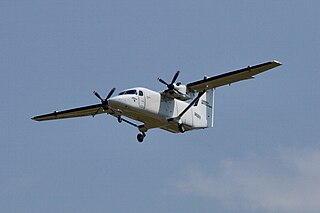
The Cessna 408 SkyCourier is an American utility aircraft designed and built by the Cessna division of Textron Aviation. It was launched on November 28, 2017, with an order for 50 from FedEx Express, with the aircraft designed for the needs of its FedEx Feeder service. It made its first flight on May 17, 2020, and was type certified on March 11, 2022. FedEx took delivery of the first production model on May 9, 2022.

The Firecatcher Aircraft F-45 is a single-turboprop aircraft designed for aerial firefighting, air freight and commuter airlines. It is financed by UK start-up Arcus Fire, designed by New Zealand firm Flight Structures and built by NZ's Pacific Aerospace. First flight is planned for 2023 and first delivery for 2024.
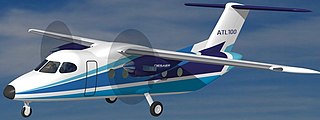
The Desaer ATL-100 is a twin-turboprop, high-wing, utility aircraft under development by Desaer in Brazil and by CEiiA in Portugal.